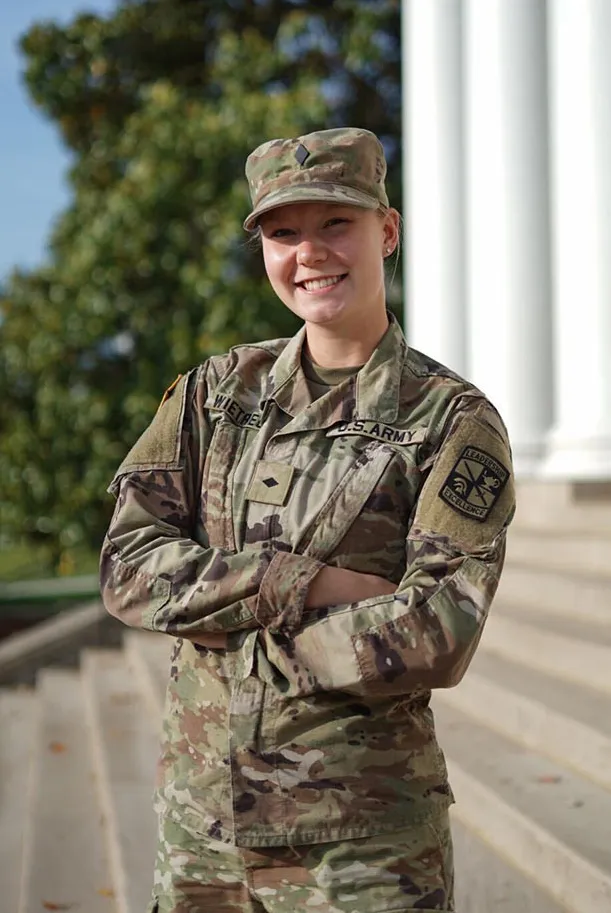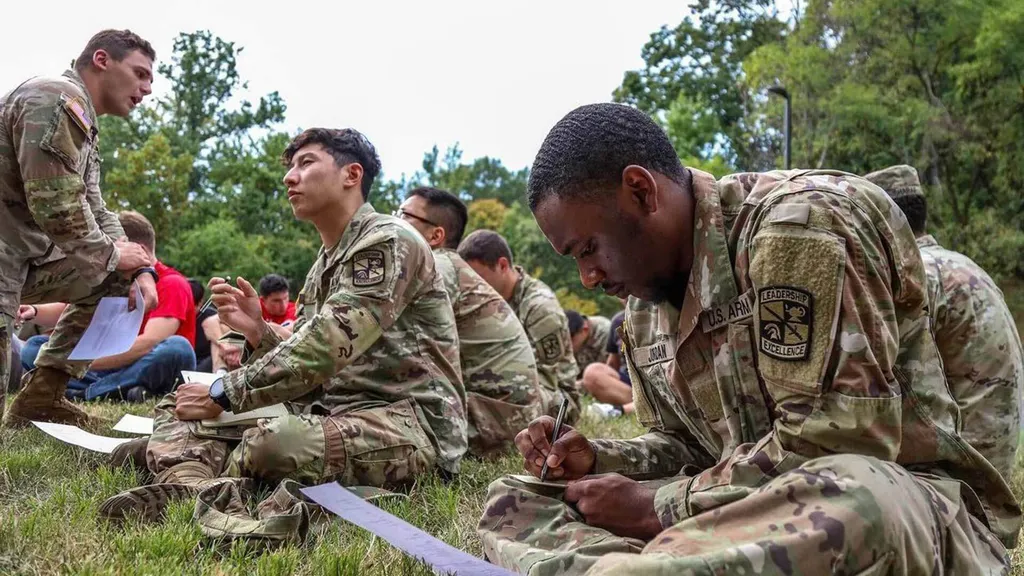- February 16, 2024
- By Karen Shih ’09
Thirty-five-pound rucksack in tow, Anna Wietrecki ’24 briefly reconsidered her life plans as she trudged past giggling students wandering back from the bars at 3 a.m.—while she was about to start a 12-mile “ruck march” (a heavily-loaded run-walk) from Reckord Armory.
But the Army Reserve Officers Training Corps (ROTC) cadet’s bleary eyes brightened at the sight of her fellow cadets, and their encouragement and camaraderie fueled her steps. By the time the sun rose, she was ready for class, and soon she blended among tens of thousands of other University of Maryland students streaming across McKeldin Mall.
Physical tests are just one of the many components of the ROTC programs at UMD, which include three branches with nearly 300 total students, all based in the Armory: the Army, Air Force and Navy. While each program has specific requirements, all include military classes, tactical training and leadership development, as well as off-site preparation at local bases.
Military classes have been offered since UMD was founded as the Maryland Agricultural College in 1856, as part of its land-grant mission. (Back then, all students were called cadets.) In 1916, the national ROTC program was established, and since then, colleges across the country have trained students to become future military leaders—the majority of newly commissioned military officers come from ROTC.
Terrence McCall, a recruiter who has been with the UMD Army ROTC program for two decades, and Wietrecki share why an English major can be a good fit for the Army, what it takes to plan a training ambush in the woods of College Park and the challenges of finding a camouflaged stick amid hills and brush and wild animals—in the dark.

Wietrecki: It’s been my dream to serve in the military since I was 8 years old—I have a lot of family in the Navy. I remember my dad at the kitchen table quoting President Kennedy: “Ask not what your country can do for you. Ask what you can do for your country.” That stuck with me.
McCall: For Army ROTC, you can join as early as the first day of your freshman year or as late as your junior year. There are a lot of requirements, but the basics are: You have to be a U.S. citizen, have a minimum GPA, and pass a medical and physical fitness test. We have about 120 cadets, pretty evenly distributed among the four classes.
People have a misconception that if you join ROTC, school is paid for, but it’s a competitive, merit-based scholarship. About 80% of our cadets get one, but another 20% sign a contract without one. After graduating, students can choose to go into active duty or into the Army Reserve or the National Guard. The length of their required duty can range from four to eight years.
Wietrecki: I’m a criminology and criminal justice major, and I’m planning to go into military intelligence.
McCall: All the ROTC programs have a preference for STEM majors, but the Army is the least adamant about that. It’s fine if you want to study poetry. Our mission is the broadest and most diverse—we need every imaginable skill set.
There’s not always a direct correlation between what you major in and what you do. Just because you major in engineering doesn’t mean you’ll be an Army engineer officer. If you want to fly a helicopter, we can teach you everything you need to know about flying that helicopter. People find that freeing, that they can go in a different direction in college.
Wietrecki: On Monday, Wednesday and Friday, we do physical training to prepare for the Army Combat Fitness Test, which is pretty hardcore. There are six components: a three-repetition deadlift, a standing power throw of a 10-pound medicine ball, pushups, a sprint-drag-carry exercise featuring a 90-pound sled, a timed plank (up to three minutes, 40 seconds) and a two-mile run.
In addition, we take one ROTC three-credit class per semester, and on Thursdays, we have a two-hour lab session. That’s when we do tactical training in the woods near Xfinity Center.

Once you get to your junior year, you get the opportunity to lead
your own mission, and you get graded on your creativity and leadership.
My favorite is an ambush. We’ll move into the woods, set up in a giant
circle with leadership in the center and figure out how to take out the
enemy. We’ll assign platoon leaders, see what the terrain looks like,
and we’ll pull freshmen and sophomore ROTC students from their labs to
come serve on the teams.
McCall: We set up signs and coordinate with campus police so they know we’re out there. We don’t want people to be nervous about seeing people in uniforms. Occasionally students or staff will come by and ask questions, and they’re welcome to look if they want to.
Wietrecki: We also have off-site field training exercises twice a semester. The land navigation course at Quantico is very grueling—one of the hardest ones you can complete. There’s tons of hills, it’s very steep, there’s a large pond in the center and sometimes you even encounter wildlife. I had a friend get followed by a coyote!
McCall: The cadets are looking for “points”—sticks that are olive green and pretty small. At night, you literally have to trip over them to find them.
Wietrecki: Most of our ROTC requirements are in the morning, so I can go to classes like a normal student during the day. Most of the time we dress normally, but for physical training, we wear black jackets and pants, and for our Army class and lab, we wear our uniforms.
We have social lives too: I’m part of our intramural basketball, soccer and volleyball teams, and I love going to all the Terps games, like football and basketball. I’m also on the board of the Beyond Shelter, a club on campus that helps address homelessness and food insecurity in the D.C. metro area. I know cadets in fraternities and sororities.
My favorite parts of ROTC are the “rucks” and the bonds we create—I’ve met my best friends in the program.
We do three “rucks” per semester, working our way up from six to eight to 12 miles. They’re usually routes near campus, but once a year, we start at Fort Myer in Alexandria, Virginia, then heading toward the Capitol and around the monuments in D.C. It’s a fun morning!
McCall: After students’ junior year, they go to Fort Knox for a four-week-long advanced camp. Six to seven thousand cadets from across the country come together. It’s their first time in a garrison environment, living in the barracks, eating in the mess hall, riding the bus.
Wietrecki: It really forces you outside your comfort zone. You think: This is real. In a year, I’m going into the Army. You break your reliance on familiarity and comfort, sleeping in a room with seven or eight people. And there’s no afternoon nap anymore!
McCall: Some parents or high school students steer away from the military, but if you look at business, industry, government—the top people in those fields, many started out in the military. We’re preparing students to lead.
This is part of a monthly series that looks behind the scenes at “what it takes” to keep the University of Maryland humming and create a vibrant campus experience. Got an idea for a future installment? Email kshih@umd.edu.
Topics
Campus & Community